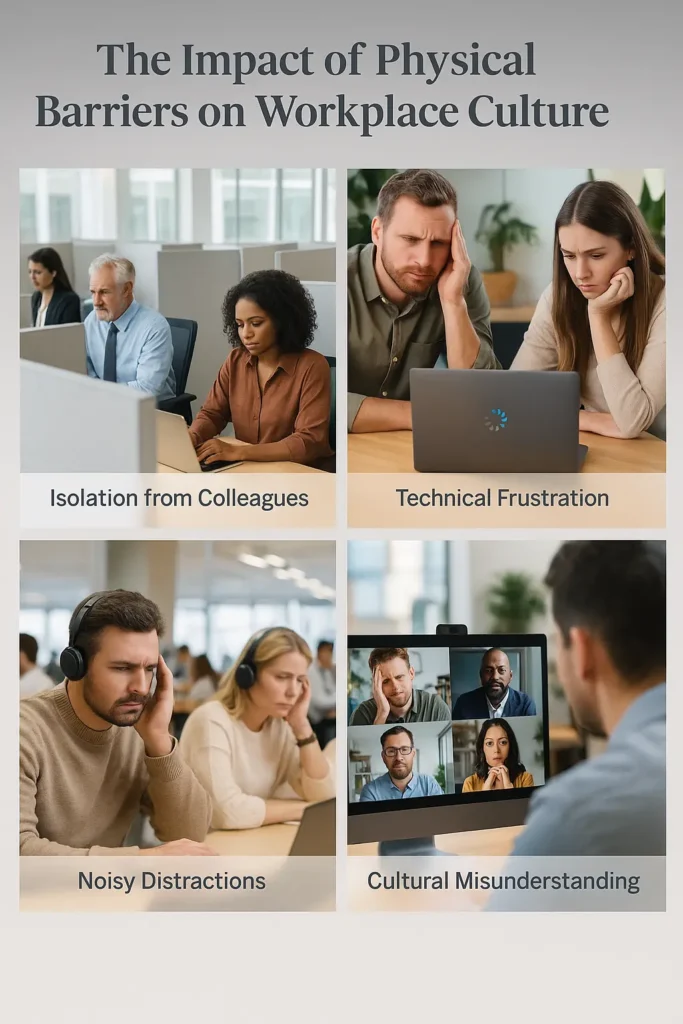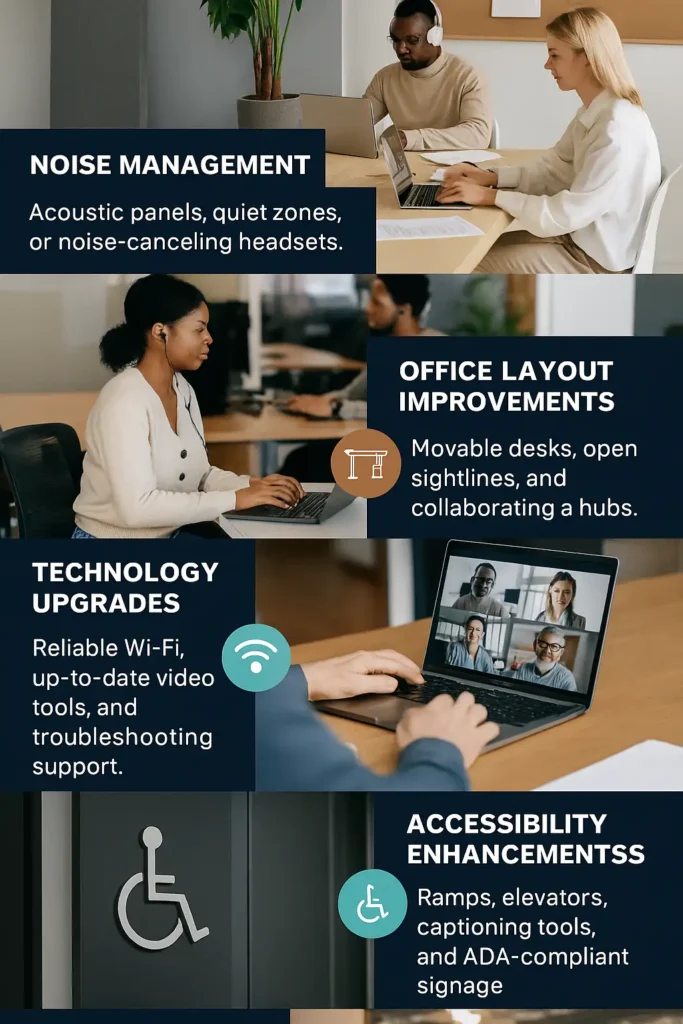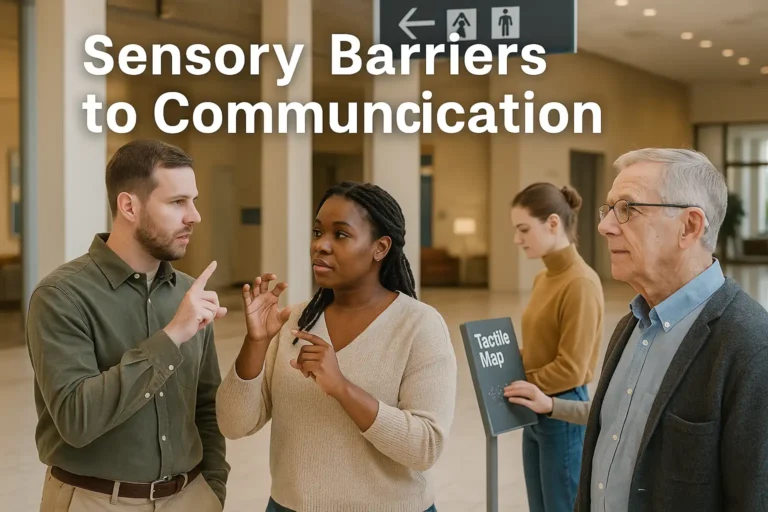Physical Barrier To Communication
Ever struggled to hear a colleague over a loud air conditioner or battled a glitchy video call? That’s a physical barrier to communication—a tangible obstacle disrupting clear workplace conversations. From noisy environments and poorly designed offices to security checkpoints or a stuffy meeting room, these hurdles lower productivity, cause misunderstandings, and stress teams out. I’ve seen how a buzzing open-plan office, a dropped call, or even an uncomfortable chair can derail important discussions or leave employees feeling frustrated.
What Is a Physical Barrier to Communication?
A physical barrier to communication is any tangible obstacle—something you can see, touch, or hear—that blocks or distorts clear message exchange in the workplace. Think loud construction noise, high partitions, spotty Wi-Fi, or even a room that’s too cold or too hot. These disrupt information flow, making collaboration tough.
Physical barriers can include:
- Environmental noise: Chatter, machinery, construction, or street traffic.
- Poor office layouts: High partitions, awkward seating, long hallways, isolated cubicles.
- Physical distance (Proxemics): How far or close you are from others impacts comfort and willingness to speak up.
- Channel noise: Static on calls, distorted video, unreadable handwriting, or visual barriers like glare and shadows.
- Accessibility issues: Lack of ramps, hearing loops, or visual alarms for employees with disabilities.
- Technical glitches: Spotty internet, outdated conferencing software, color-blind-unfriendly visuals, or faulty microphones.
- Temperature and air quality: Uncomfortable heat, cold, glare, or stuffiness that distracts from conversation.
- Security measures: Locked doors, ID checks, or restricted areas can sometimes slow down communication.
- Ergonomic issues: Poor chair design, improper desk height, or screen glare that leads to fatigue.
- Information overload: Endless emails, long-winded reports, or poorly organized content.
Why Physical Barriers Matter
Physical barriers don’t just slow things down—they create a ripple effect across your business or organization:
- Reduced productivity: Misunderstandings mean wasted time clarifying or redoing tasks.
- Lower morale: Employees feel frustrated, isolated, or even ignored.
- Missed nonverbal cues: Dim lighting, high partitions, or video glitches can hide facial expressions or gestures.
- Limited inclusion: Employees with disabilities may be left out if spaces or tech aren’t accessible.
- Lost opportunities: When teams can’t connect, creativity and collaboration suffer.
- Fatigue and discomfort: Bad lighting, uncomfortable temperatures, or poor ergonomic setups increase fatigue and reduce engagement.
- Safety risks: In emergencies, blocked exits or unclear alarms may create confusion.
A 2023 SHRM study found 70% of employees rate noise as a major distraction, while a 2024 Gartner report reveals 68% of remote teams experience collaboration problems due to tech failures.
Causes of Physical Barriers to Communication
A physical barrier to communication arises from environmental and technological issues. Let’s break down the main causes and their effects.
Noise Disruptions
Loud environments—whether from office chatter, construction, or even background noise at home—force people to raise their voices or repeat themselves. In virtual meetings, static or background sounds can garble important points. Using decibel meters or sound-absorbing panels can help monitor and control noise levels.
Inefficient Office Layouts & Proxemics
High cubicle walls, long hallways, or sprawling campuses make it harder for people to communicate naturally. Even open offices can backfire if acoustics aren’t managed well, turning them into echo chambers. Poor proxemics—the study of personal space—means some people may feel isolated or, conversely, uncomfortable if desks are too close together.
Technical Problems & Visual Barriers
Unstable Wi-Fi, old webcams, malfunctioning microphones, or a lack of captioning tools can stop digital conversations before they start. Poor lighting, screen glare, or visual clutter may also block nonverbal cues. Color combinations on slides or dashboards that aren’t accessible for people with color blindness can also be a problem. Using high-contrast visuals and screen-reader-friendly formats supports everyone.
Temperature, Lighting, and Air Quality
Rooms that are too hot, cold, or stuffy drain focus. Harsh lighting or glare hides facial expressions and causes eye strain. These physical discomforts add up, especially during long meetings.
Security Measures and Physical Access
Locked doors, badge checkpoints, or restricted zones are often needed for safety, but they can also slow urgent communications or separate teams. Clear, accessible signage and well-placed communication boards are important for navigating large or secure spaces.
Accessibility Gaps
Without ramps, elevators, hearing loops, Braille signage, or captioning, employees with mobility, vision, or hearing impairments may be unable to fully participate. Accessibility guidelines like ADA and WCAG set standards, but regular audits are needed to stay compliant and inclusive.
Ergonomic Barriers and Fatigue
Uncomfortable chairs, non-adjustable desks, or poorly placed screens cause fatigue, which reduces engagement and communication quality. Ergonomically designed spaces help employees focus and connect better.
Time, Distance, and Hybrid Work Challenges
Teams split across cities or continents face time zone clashes, making real-time discussions tricky. Hybrid work and hot desking bring new challenges—lack of dedicated space, inconsistent equipment, and fewer informal chats. Scheduling tools and clear booking systems help bridge the gap.
Information Overload
Too many emails or lengthy reports can hide key messages, especially when teams are already distracted or overwhelmed. Simplified, visual, or summarized communication can help.
Emergency Communication and Signage
Physical barriers may prevent some employees from seeing or hearing alarms. Multi-modal alerts—combining audio, flashing lights, vibration, and clear signage—are essential, especially for large or diverse workplaces.
Cultural and Diversity Impacts

Physical barriers influence not just words, but workplace culture—especially in diverse organizations:
- Isolation and Fragmentation: Poor layouts or remote work can isolate cultural groups, limiting informal exchanges and reinforcing stereotypes.
- Cultural Space Norms: Different cultures have unique expectations around personal space and gestures. Physical barriers may reinforce or disrupt these norms, leading to accidental misunderstandings.
- Reduced Sensitivity: When remote teams miss face-to-face time, they lose exposure to customs and nonverbal cues that build empathy and respect.
- Accessibility as Inclusion: Following ADA and WCAG guidelines with ramps, visual alarms, and adaptive tech supports a diverse team and signals that every employee matters.
Psychological Effects of Physical Barriers
Physical barriers are more than a nuisance—they impact mental health. According to the American Psychological Association (2023):
Over time, these factors contribute to higher turnover.
- Noise increases stress by up to 34%.
- Isolated layouts make employees feel disconnected, lowering trust.
- Tech issues create frustration, disengagement, and even burnout.
- Poor ergonomics and discomfort lead to fatigue and a drop in morale.
Types of Physical Barriers to Communication
| Type | Description | Example |
|---|---|---|
| Environmental Noise | Loud sounds disrupt focus and speech | Machinery, office chatter, street traffic |
| Architectural Layouts | Distance, walls, lack of visual contact | High partitions, long hallways, separate buildings |
| Physical Distance | Proxemics—how close/far people are | Distant meeting rooms, crowded desk arrangements |
| Technical Glitches | Problems with digital tools or infrastructure | Video freezing, bad audio, unstable internet |
| Visual Barriers | Poor lighting, screen glare, visual clutter | Glare on monitors, dim rooms, poor slide contrast |
| Accessibility Gaps | Inadequate facilities for disabilities | No ramps, lack of captions, small text on screens |
| Ergonomic Issues | Physical discomfort impeding focus | Uncomfortable chairs, poor desk design |
| Security Measures | Access controls blocking information flow | Locked doors, security checkpoints |
| Time/Distance | Remote or global teams face connection issues | Time zone clashes, async collaboration |
| Information Overload | Too much data clouds the message | Long emails, endless threads |
| Emergency Protocols | Barriers delay or block critical alerts | Blocked exits, unclear signage, inaudible alarms |
Assessing Physical Barriers in Your Workplace
Assessing Physical Barriers in Your Workplace
A quick workplace audit helps you spot and prioritize fixes. Use this checklist:
- Do employees report difficulty hearing or seeing in meetings?
- Is your office layout open and collaborative, or do teams feel isolated?
- Are meeting rooms equipped with captioning, hearing loops, and accessible signs?
- Is technology reliable and user-friendly for both in-person and remote meetings?
- Are all spaces fully accessible per ADA and WCAG guidelines?
- Do emergency protocols use multi-modal alerts and clear signage?
- Does digital communication consider language, culture, and visual accessibility?
- Are ergonomic standards regularly reviewed and updated?
- Are security measures necessary but not excessive?
Solutions to Overcome a Physical Barrier to Communication

Tackling physical barriers takes practical, often budget-friendly strategies:
Use Technology Effectively
Choose video call platforms with reliable connections, live captions, and sound suppression. Provide training on using tools like Otter.ai for real-time transcriptions. Keep backup tech (like portable Wi-Fi or extra headsets) handy.
Redesign Workspaces for Collaboration and Comfort
Lower partitions, rearrange desks for better visibility, and install acoustic panels to control noise. Use glass walls to balance privacy and transparency. Ensure ergonomic furniture and adjustable lighting. Regularly check temperature and air quality.
Ensure Accessibility and Inclusion
Follow ADA and WCAG guidelines: ramps, elevators, Braille signage, hearing loops, and screen-reader compatibility for all digital content. Train teams on accessibility features and encourage feedback for continuous improvement.
Manage Noise and Environmental Factors
Provide noise-canceling headsets, set up quiet zones, and use sound-absorbing materials. Schedule regular noise and air quality audits. Address glare with blinds or better lighting.
Bridge Time, Distance, and Hybrid Work Barriers
Leverage scheduling tools (Calendly, WorldTimeBuddy) to coordinate across zones. Record meetings with timestamps for those who can’t join live. Offer flexible, bookable spaces for hybrid and hot-desking teams.
Simplify and Prioritize Communication
Keep emails and reports brief—use bullet points, summaries, and visuals. Use Slack or Teams to minimize unnecessary notifications. Avoid information overload by summarizing key messages and supporting with visuals.
Support Employees with Disabilities
Regularly audit for accessibility. Provide support and training for adaptive technologies. Ensure emergency protocols are inclusive, using multi-modal alerts.
Balance Security and Communication
Design security protocols that keep the workplace safe without cutting off communication. Use clear signage and accessible contact points in secure areas.
Invest in Ergonomics and Comfort
Upgrade chairs, desks, and screens for better ergonomics. Educate staff on posture and equipment setup. Monitor fatigue and address discomfort quickly.
Leadership’s Role in Reducing Physical Barriers
Leaders set the tone for clear, inclusive communication. Conduct regular barrier reviews, invest in high-impact upgrades (like tech or accessibility fixes), and model best practices for collaboration. Offer training on cultural sensitivity, accessibility, and ergonomics for managers and staff. Listen to employee feedback and adapt as the workplace evolves.
Emerging Technologies for Physical Barriers
- AI-powered transcription: Tools like Otter.ai and Microsoft Teams offer automatic captions and meeting summaries.
- Spatial audio: More natural sound environments in virtual meetings.
- Smart offices: IoT sensors adjust lighting, air, and acoustics in real time.
- VR meetings: New platforms simulate in-person cues for remote teams.
- Continuous assessment: Decibel meters, accessibility checklists, and air quality sensors help maintain optimal environments.
The 2025 Forrester Report predicts 40% of companies will use AI communication tools by 2027.
Conclusion
A physical barrier to communication—like noise, poor layouts, security checkpoints, or tech glitches—disrupts workplace productivity and culture. By regularly assessing your environment, using modern tools, and prioritizing accessibility, you can break down these obstacles and create a workplace where every message is clear and every employee feels connected. Remember, overcoming physical barriers in communication isn’t a one-time fix—it’s an ongoing process that pays off for everyone, from new hires to senior leaders.



